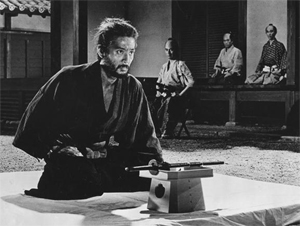 Set in 1630, Harakiri, directed by Masaki Kobayashi who also directed Samurai Rebellion, is an exploration of the samurai code and feudal system vs. individual freedom. Starring Tatsuya Nakadai, the movie questions whether the samurai code is more important than an individual's rights. Set in 1630, Harakiri, directed by Masaki Kobayashi who also directed Samurai Rebellion, is an exploration of the samurai code and feudal system vs. individual freedom. Starring Tatsuya Nakadai, the movie questions whether the samurai code is more important than an individual's rights.
Times are bad and ronin are being let go, it is a peaceful time. Ronin are showing up at feudal houses and saying that because of the lack of work, they want to commit hari-kari. The houses are giving the ronin something small and sending them on their way. One house decides that they will put a stop to this extortion. They force a young samurai to go through with the seppuku. It is particularly brutal since he had already sold his swords and just had ones made of bamboo.
Hanshiro Tsugumo (Tatsuya Nakadai) then shows up at the house to commit seppuku. One of the retainers there tells him the brutal story of the young samurai. Hanshiro insists on going through with it, but at the ceremony insists on telling the story of his son-in-law, Motome, whose baby was dying because of a lack of money to buy medicine which forced him to come to this house. He also tells them how the baby died and then his daughter died. Hanshiro then shows all the members of the clan the three top knots he has taken from their three best swordsmen.
The movie is a little slow, and not for all tastes, but I love it. There is no sword fighting until the end, and then it veers towards the absurd. But it is an early fascinating exploration of the changing view of Japanese cinema towards the rights of the individual vs. one's duty to society. Tatsuya's comments in the movie that the samurai code is a facade very well might have been targeting the Japanese world view before WWII. The movie ends with a nod to John Ford as the people in charge make sure to "print the legend", when reporting the events, just like they did in Fort Apache and The Man Who Shot Liberty Valance.
|